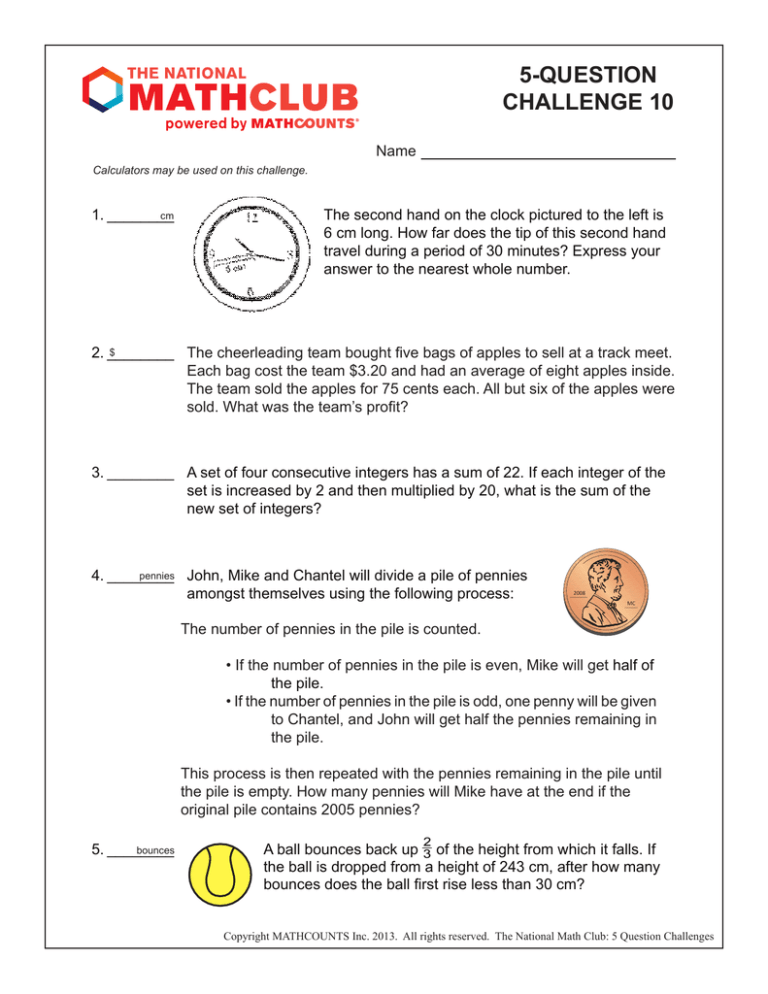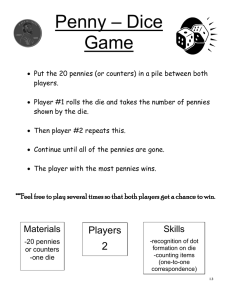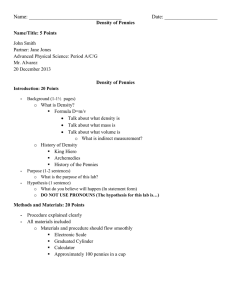
5-QUESTION
CHALLENGE 10
Name
Calculators may be used on this challenge.
cm
1.��������
The second hand on the clock pictured to the left is
6 cm long. How far does the tip of this second hand
travel during a period of 30 minutes? Express your
answer to the nearest whole number. $
2.��������
The cheerleading team bought five bags of apples to sell at a track meet. Each bag cost the team $3.20 and had an average of eight apples inside.
The team sold the apples for 75 cents each. All but six of the apples were
sold. What was the team’s profit?
3.�������� A set of four consecutive integers has a sum of 22. If each integer of the
set is increased by 2 and then multiplied by 20, what is the sum of the
new set of integers? pennies John, Mike and Chantel will divide a pile of pennies
4.��������
amongst themselves using the following process:
The number of pennies in the pile is counted.
2008
MC
• If the number of pennies in the pile is even, Mike will get half of the pile.
• If the number of pennies in the pile is odd, one penny will be given to Chantel, and John will get half the pennies remaining in the pile.
This process is then repeated with the pennies remaining in the pile until the pile is empty. How many pennies will Mike have at the end if the original pile contains 2005 pennies? 2
bounces
5.��������
A ball bounces back up 3 of the height from which it falls. If
the ball is dropped from a height of 243 cm, after how many
bounces does the ball first rise less than 30 cm? Copyright MATHCOUNTS Inc. 2013. All rights reserved. The National Math Club: 5 Question Challenges
s
it on
5-QUESTION
CHALLENGE 10
olu
S
Name
Calculators may be used on this challenge.
1131 cm
1.��������
The second hand on the clock pictured to the left is
6 cm long. How far does the tip of this second hand
travel during a period of 30 minutes? Express your
answer to the nearest whole number. Each minute, the second hand makes one full rotation. So, in 30 minutes the
second hand makes 30 rotations. To find out how far that is we must first find the
circumference of the path of the tip of the second hand. We know the radius of
the path to be 6 cm, thus the circumference is 2(6)� = 12� cm. Multiplying by 30,
we find that the tip of the second hand travels (12�)(30) = 360� = 1131 cm, to the
nearest whole number.
$ 9.50
2.��������
The cheerleading team bought five bags of apples to sell at a track meet. Each bag cost the team $3.20 and had an average of eight apples inside.
The team sold the apples for 75 cents each. All but six of the apples were
sold. What was the team’s profit?
The team spent a total of 5 × $3.20 = $16.00 and bought 5 × 8 = 40 apples. They
sold 34 apples (all but six) for $0.75 each, for a total of $25.50 in sales. Their profit
was $25.50 – $16.00 = $9.50.
600
3.��������
A set of four consecutive integers has a sum of 22. If each integer of the
set is increased by 2 and then multiplied by 20, what is the sum of the
new set of integers? Let x = the first integer in the set.
Then: x + x + 1 + x + 2 + x + 3 = 22 → 4x + 6 = 22 → 4x = 16 → x = 4.
The four consecutive integers are 4, 5, 6 and 7. Now add 2 to each and then multiply by 20. ((4 + 2) × 20) + ((5 + 2) × 20) + ((6 + 2) × 20) + ((7 + 2) × 20) = (6 × 20) + (7 × 20) + (8 × 20) + (9 × 20) = (6 + 7 + 8 + 9) × 20 = 30 × 20 = 600.
Copyright MATHCOUNTS Inc. 2013. All rights reserved. The National Math Club: 5 Question Challenges
657 pennies John, Mike and Chantel will divide a pile of pennies amongst
4.��������
themselves using the following process:
2008
MC
The number of pennies in the pile is counted.
• If the number of pennies in the pile is even, Mike will get half of the pile.
• If the number of pennies in the pile is odd, one penny will be given to Chantel, and John will get half the pennies remaining in the pile.
This process is then repeated with the pennies remaining in the pile until the pile is empty. How many pennies will Mike have at the end if the original pile contains 2005 pennies? -1- They start with 2005 pennies, which is odd, so Chantel gets one and John gets half
for 1002. J: 1002, M: 0, C: 1. There are 2005 – 1003 = 1002 pennies left.
The
number
of pennies
-2is even so Mike gets half or 501. J: 1002, M: 501, C:1.
There are 501 pennies left.
-3- The number of pennies is odd so Chantel gets one and John gets half of 500 or
250. J: 1252, M: 501, C: 2. There are 250 pennies left.
-4- The number of pennies is even so Mike gets half or 125. J: 1252, M: 626, C: 2
There are 125 left.
-5- Chantel gets 1 and John gets (0.5)(124) = 62. J: 1314, M: 626, C: 3. There are 62 left.
-6- Mike gets half of 62 or 31. J: 1314, M: 657, C: 3. There are 31 left.
-7- Chantel gets 1, John gets 15 and 15 are left. J: 1329, M: 657, C: 4
-8- Chantel gets 1, John gets 7 and 7 are left. J: 1336, M: 657, C: 5
-9- Chantel gets 1, John gets 3 and 3 are left. J: 1339, M: 657, C: 6
-10- Chantel gets 1, John gets 1 and 1 is left. J: 1340, M: 657, C: 7
-11- Chantel gets 1. J: 1340: M: 657, C: 8. Thus Mike ends up with 657 pennies.
2
6 bounces
5.��������
A ball bounces back up 3 of the height from which it falls. If
the ball is dropped from a height of 243 cm, after how many
bounces does the ball first rise less than 30 cm? 2
After the first bounce it comes back up to: 243 × 3 = 162 cm. After the second bounce it
comes back up to: 162 × 23 = 108 cm. After the third bounce it comes back up to: 108 ×
2
2
3 = 72 cm. After the fourth bounce it comes back up to: 72 × 3 = 48 cm. After the fifth
2
bounce it comes back up to: 48 × 3 = 32 cm. And, after the sixth bounce it comes back
2
1
up to: 32 × 3 = 21 3 cm.
So it’s after the sixth bounce that the ball first rises less than 30 cm.
Copyright MATHCOUNTS Inc. 2013. All rights reserved. The National Math Club: 5 Question Challenges


